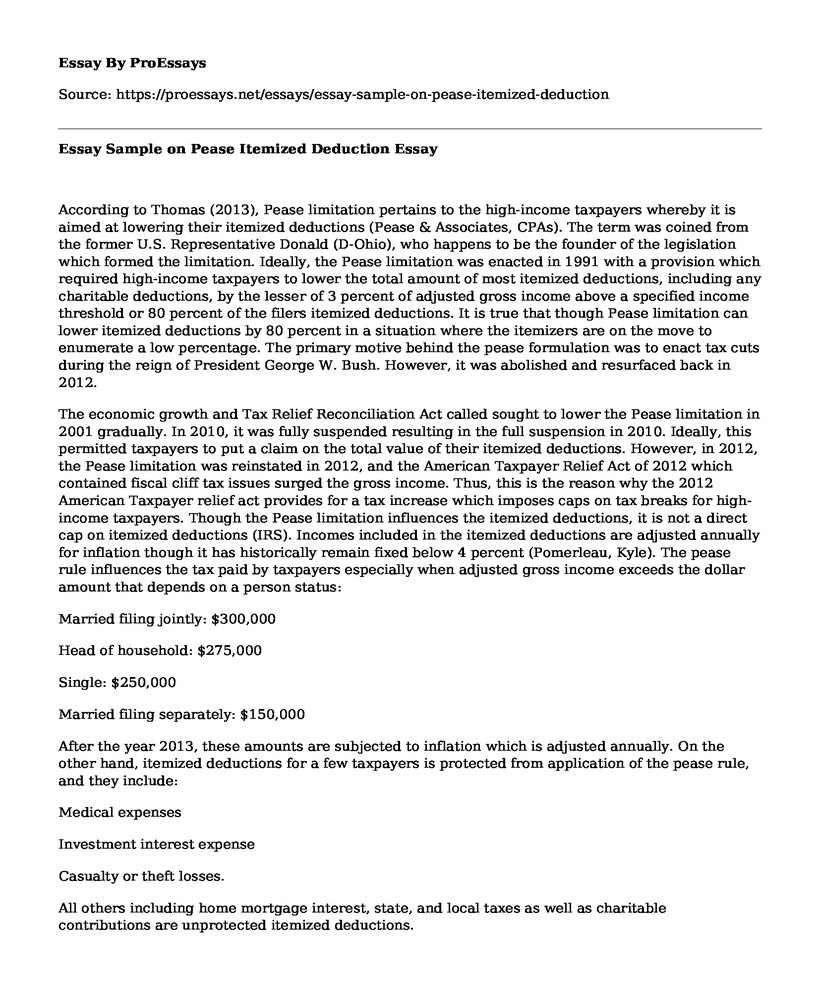According to Thomas (2013), Pease limitation pertains to the high-income taxpayers whereby it is aimed at lowering their itemized deductions (Pease & Associates, CPAs). The term was coined from the former U.S. Representative Donald (D-Ohio), who happens to be the founder of the legislation which formed the limitation. Ideally, the Pease limitation was enacted in 1991 with a provision which required high-income taxpayers to lower the total amount of most itemized deductions, including any charitable deductions, by the lesser of 3 percent of adjusted gross income above a specified income threshold or 80 percent of the filers itemized deductions. It is true that though Pease limitation can lower itemized deductions by 80 percent in a situation where the itemizers are on the move to enumerate a low percentage. The primary motive behind the pease formulation was to enact tax cuts during the reign of President George W. Bush. However, it was abolished and resurfaced back in 2012.
The economic growth and Tax Relief Reconciliation Act called sought to lower the Pease limitation in 2001 gradually. In 2010, it was fully suspended resulting in the full suspension in 2010. Ideally, this permitted taxpayers to put a claim on the total value of their itemized deductions. However, in 2012, the Pease limitation was reinstated in 2012, and the American Taxpayer Relief Act of 2012 which contained fiscal cliff tax issues surged the gross income. Thus, this is the reason why the 2012 American Taxpayer relief act provides for a tax increase which imposes caps on tax breaks for high-income taxpayers. Though the Pease limitation influences the itemized deductions, it is not a direct cap on itemized deductions (IRS). Incomes included in the itemized deductions are adjusted annually for inflation though it has historically remain fixed below 4 percent (Pomerleau, Kyle). The pease rule influences the tax paid by taxpayers especially when adjusted gross income exceeds the dollar amount that depends on a person status:
Married filing jointly: $300,000
Head of household: $275,000
Single: $250,000
Married filing separately: $150,000
After the year 2013, these amounts are subjected to inflation which is adjusted annually. On the other hand, itemized deductions for a few taxpayers is protected from application of the pease rule, and they include:
Medical expenses
Investment interest expense
Casualty or theft losses.
All others including home mortgage interest, state, and local taxes as well as charitable contributions are unprotected itemized deductions.
However, the majority of the taxpayers with high-income levels are in one way or another affected by the pease rule. Most of them have large unprotected itemized deductions in a manner such that the 80 percent is irrelevant and the only applicable principal is the 3 percent rule (Thomas, Kaye A).
Works Cited
Barker, Gene. "Limitations for High-Income Taxpayers." MD Magazine. N.p., 16 May 2013. Web. 28 May 2017.
IRS. "Publication 17 (2016), Your Federal Income Tax." Internal Revenue Service. N.p., n.d. Web. 28 May 2017.
Pease & Associates, CPAs. "Beware of Income-based Limits on Itemized Deductions and Personal Exemptions - Pease & Associates, CPAs." Pease & Associates, CPAs. N.p., Oct. 2016. Web. 28 May 2017.
Peters, Cathy. "Phaseout of Itemized Deductions and Personal Exemptions for High-Income Taxpayers." BCS Blog. N.p., n.d. Web. 28 May 2017.
Pomerleau, Kyle. "The Pease Limitation on Itemized Deductions Is Really a Surtax." Tax Foundation. N.p., Oct. 2014. Web. 28 May 2017.
Thomas, Kaye A. "Pease Reduction in Itemized Deductions Fairmark.com." Fairmark.com. N.p., Jan. 2013. Web. 28 May 2017.
Cite this page
Essay Sample on Pease Itemized Deduction. (2021, Jun 17). Retrieved from https://proessays.net/essays/essay-sample-on-pease-itemized-deduction
If you are the original author of this essay and no longer wish to have it published on the ProEssays website, please click below to request its removal:
- Measuring Safety's Return on Investment Essay
- Planning and Budgeting in Pharmacy Services - Paper Example
- Taxes to Fund Homelessness Services Paper Example
- Essay Sample on Evaluation of ICT Driven FDI on Economic Development/Growth
- Paper Example on Tax Benefits of Claiming a Qualifying Relative as Dependent
- Stock Prices Reflect Data: Productive Market Hypothesis - Essay Sample
- Essay Sample on U.S. Healthcare Fraud: Putting Profits Ahead of Patient Care







